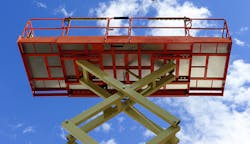Scissor Lift Accidents Spur OSHA to Issue Hazard Warning
A spate of accidents involving scissor lifts has caused the Occupational Safety and Health Administration (OSHA) to issue a hazard alert outlining employers’ obligations and preventive measures.
Scissor lifts aren’t just used in warehousing; they also are common in the construction, retail, entertainment and manufacturing industries, among others.
OSHA points out that over a one-year period it had investigated 10 fatalities and more than 20 other serious injuries it termed preventable involving scissor lifts. OSHA says it found that most of these injuries and fatalities were the result of employers not properly addressing fall protection, stabilization and positioning.
OSHA reminds employers that only trained workers should be allowed to use scissor lifts, and employers should make sure that those workers show that they can use a scissor lift properly.
Training must at a minimum include manufacturer’s instructions for operating and moving the lift, handling materials on the lift, including weight limits, and other worksite hazards workers could encounter, such as contact with electrical wires. OSHA stresses that training must cover reporting any equipment defects or maintenance needs.
Employer obligations include making sure the equipment is properly maintained, manufacturer’s instructions are followed, personal protective equipment is worn, and safe work practices are practiced.
To avoid falls, lift platforms must have guardrails, and employees should be trained to check to make sure a guardrail is in place, only stand on the work platform, never stand on the guardrails, and keep work within easy reach to avoid leaning away from the lift.
To assure stabilization OSHA notes that manufacturer instructions for safe movement usually rule out moving the lift in an elevated position. Isolate the scissor lift or implement traffic control measures to ensure that other equipment cannot contact the scissor lift, the agency says. Also select work locations with firm, level surfaces away from hazards that can cause instability, such as drop-offs, holes, slopes, bumps, ground obstructions, or debris.
Use the scissor lift outside only when weather conditions are good, OSHA adds, noting that scissor lifts rated for outdoor use are generally limited to wind speeds of less than 28 miles per hour.
OSHA cites the example of a student employee of the University of Notre Dame who was killed in 2010 while filming a football practice from a scissor lift. Untrained, he chose to raise the lift more than 39 feet, and winds gusting more than 50 miles per hour blew the lift over.
“Positioning the scissor lift to avoid electrocution, arc flash and thermal burns is important for safely using scissor lifts near energized power lines,” OSHA warns. “Since electricity can arc or jump from the power line to the scissor lift or worker, electrocution can occur even if neither the scissor lift nor the worker touches the power line.”
Although rare, the collapse of scissor lifts can be prevented if employers ensure that safety systems designed to stop collapsing are maintained and not bypassed. Never allow the weight on the work platform to exceed the manufacturer’s load rating. Never allow equipment other than the scissor mechanism to be used to raise the work platform—including using a forklift to lift it.
“Scissor lifts provide a safe and reliable platform for workers to perform job tasks when used according to the manufacturer’s instructions,” OSHA says. “When not used properly, scissor lifts can present a serious hazard to workers. Employers are responsible for keeping workers safe.”
About the Author

David Sparkman
founding editor
David Sparkman is founding editor of ACWI Advance (www.acwi.org), the newsletter of the American Chain of Warehouses Inc. He also heads David Sparkman Consulting, a Washington D.C. area public relations and communications firm. Prior to these he was director of industry relations for the International Warehouse Logistics Association. Sparkman has also been a freelance writer, specializing in logistics and freight transportation. He has served as vice president of communications for the American Moving and Storage Association, director of communications for the National Private Truck Council, and for two decades with American Trucking Associations on its weekly newspaper, Transport Topics.
